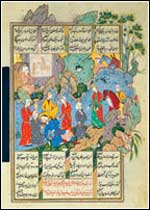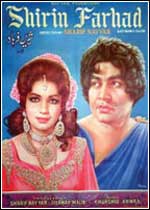DAWN Images November 20, 2005
The Onscreen Love of Shirin Farhad
 |
 |
| Above
left: Miniature from Persian MSS illustrating the legend
of Shirin Farhad. Above Right: Poster of Pakistani movie
based on the legend |
The story of Shirin has been treated
in film and drama in India, Pakistan, Iran and Turkey. The best
known to us are, of course, the Indian version from the 1950s
which had songs by Talat Mehmood and, more notably, the Pakistani
version from the 1970s starring Mohammad Ali and Zeba, and featuring
music by Khwaja Khurshid Anwer (including the famous song Ishq
mera dewana by Mehdi Hasan).
Most of these dramatic versions simply followed whatever formula
happened to be current in the media at that time. The literary
refinement of the classics was seldom reflected.
Shirin was a Christian princess from Armenia and lived in the
sixth century AD. She got married to Khusrau Pervaiz, the powerful
Persian emperor of the Sassanid dynasty (and incidentally a
grandson of Nausherwan the Just). The Persians remembered her
by the name Shirin. Apparently it was a corruption of Irene
but at the same time meant ‘sweet’ in the language
of Persia.
In all probability, her marriage was a political one. Historical
facts are scarce, since the Arabs overran the country soon after
her husband’s death. Persia was reduced to a mere province
of the vast Arab empire that stretched from Spain to Sindh.
The new empire was centralist in nature, in which native cultures
were at best viewed with suspicion and at worst completely suppressed.
Pehlavi (the language spoken in ancient Persia) became a dead
language or at least it was never written again. The situation
lasted for three centuries.
Sometime in the 10th century,
the Arab empire started falling apart. Sindh, Egypt, Turkey,
Afghanistan and parts of Persia became independent, very often
under native rulers whose ancestors had converted to Islam.
Mahmud Ghaznavi, Salahuddin Ayubi and Alp Arsalan Saljuqi are
some of the best examples of these rulers.
Many of them paid nominal allegiance to the Arab caliph at Baghdad
but encouraged movements for the revival of regional biases,
cultures, and even regional jealousies. Pehlavi language could
not be revived but the pride of the Persian people (now mostly
Muslim) worked up the birth of a new language out of the old
tongue. It was the language today known as Persian — a
hybrid of Pehlavi and Arabic vocabulary, following Pehlavi grammar
in most instances but written in the Arabic script.
Mahmud Ghaznavi was among the greatest patrons of this new language
and encouraged historians to discover and record the pre-Islamic
glory of Persia. Mahmud was a staunch liberal where it didn’t
concern his prejudice against the minority sects of Islam or
his political rivalry with the Indian rulers. He also commissioned
the writing of the first great masterpiece in Persian. This
was the Shahnamah, or the Book of Kings, written by Firdausi
around 1226 AD. From this book originates the love story of
Shirin as higher literature.
Firdausi described Khusrau as a prince who fell in love with
the Armenian princess and won her hand after much effort. As
husband and wife, or king and queen, they lived like role models
of a passionate couple — sort of an earlier day Jahangir
and Nurjehan. When Khusrau’s son from another wife killed
him and wanted to marry Shirin, she asked permission to spend
a night at her dead husband’s tomb before taking a new
one. This was granted but, unsuspected, she smuggled a dagger
and stabbed herself to death over her lover’s coffin.
It is obvious that Firdausi was working from some written histories
(now lost to us) and a lot of oral tradition, but above all,
he also took into account the various folk tales that had developed
around the Persian kings by that time. These were produced by
three centuries of nostalgia about a forbidden past. In these
tales, Shirin was exceedingly beautiful and Khusrau was a passionate
young man. Apparently, the Persians had remembered him in a
very different manner than the Arab historians for whom he was
mainly the impudent monarch who failed to honour the message
of Islam in his court. However, it seems that either Firdausi
or one of the writers of these folk stories was also inspired
from a very unexpected fictional source — the Greek story
of Pyramus and Thisbe.
In that story, which was also narrated by the Latin poet Ovid
in Metamorphosis, Thisbe stabs herself at the tomb of her dead
lover Pyramus (the story later inspired that string of novels
about Romeo and Juliet that were finally adapted by William
Shakespeare for the Elizabethan stage). Apparently, Shirin became
Thisbe in the folk memory of Persia and the great poets, starting
from Firdausi, carved that image on words that will last longer
than marble and gilded stones.
Firdausi didn’t mention Farhad. However, a folk story
had developed around a sculptor, Farhad, who engineered a stream
of milk for her and then fell in love while Khusrau was still
wooing her. Khusrau invited Farhad to his court, questioned
him and then promised to give him Shirin if he removed the Bestoun
Mountain from its place as it was blocking a passage to the
royal palace.
The sculptor, in a frenzy of passion, actually removed the mountain
with his pickaxe, at which Khusrau sent an old woman to misinform
Farhad that Shirin was dead. Upon hearing this news, the sculptor
killed himself with his pickaxe.
The first great poet to weave the Farhad legend into the love
story of Shirin and Khusrau was Nizami Ganjavi, who lived in
Azarbaijan in the 12th century AD. His native city — Ganjeh
— was near Baku and hence not very far away from Armenia,
the original country of Shirin (Irene). Also, his wife Afaq,
whom he loved passionately, was a former slave girl given to
him by a king as a reward for writing a magnificent epic.
Nizami could relate himself to Farhad, only a lot more fortunate
one, for he too had worked hard (in writing an epic instead
of carving a mountain) and found a beautiful woman in reward
(which Farhad had only been promised but never actually received).
Afaq, then, was a role model of Shirin for him.
Consequently his next epic turned out to be Khusrau Shirin,
written in 1191. It was the first full-length treatment of the
story that had merely filled a chapter in Firdausi’s epic.
It was also the poem that gave birth to literally all the conventions
followed in the love poetry of Persian (and later Urdu) ever
since.
Nizami, however, depicted Shirin as in love with Khusrau. She
didn’t reciprocate to Farhad’s essentially one-sided
crush on her although she was sympathetic towards the great
sculptor. To be in love with a pauper but marry a king would
render her unfaithful and greedy, and that Nizami couldn’t
do since his ulterior motive, most probably, was to immortalize
his wife Afaq through a Shirin modelled after her.
Nizami effectively used the fate of Farhad as a mirror to Shirin
— both kill themselves with a sharp weapon but Farhad
succumbs to deceit while Shirin manages to follow her lover
in the other world. Farhad’s love did not carry the ‘grace’
(in a mystical sense), while hers did. One can almost feel that
both Farhad and Khusrau represent Nizami. The sculptor represents
the poet’s present station, which he yearns to surpass.
The king represents the station he is yearning to achieve (and
which he probably achieved as we can see in his next great epic,
Layla Majnun).
Nizami’s epic immortalized Shirin for once and for all.
There were numerous imitations of Nizami, countless renderings
of the Shirin-Khusrau tale in the centuries to come. Perhaps
the most illustrious of such imitators was the great musician
and poet Amir Khusrau, who lived in India nearly a century after
Nizami. He wrote five epic poems to match the set of five written
by Nizami, and this included Shirin Khusrau.
In this later version, however, the Persian king became a villain
(a Turk by origin and an Indian by location, Amir Khusrau could
experience little natural sympathy with the Persian king with
whom he shared nothing but a common name). Here, Shirin was
also in love with Farhad but Khusrau gained her through deceit.
Shirin was a woman who, of course loved a sculptor but married
a king out of necessity.
Other poets interpreted it as her frailty and a moral taint
in her character. (The growth of this character parallells the
growth of Cressida in European literature, who was simply an
abducted girl in Homer but gradually became a woman who leads
on two men and betrays the truer of them — ending up almost
as a harlot in Shakespeare’s play Troilus and Cressida).
The classical Urdu poets were often condescending or critical
towards Farhad. For instance, Ghalib described him as someone
who reduced the grandeur of love to free labour for the beautification
of the royal palace. In another couplet, he pejoratively stated,
“Do we not possess a liver that we should use our craft
on a mountain instead?”
Iqbal, following in the footsteps of Ghalib, mentioned Farhad
in a similar vein in his early poetry. However, in his later
poetry he became the first great Urdu poet to hail the sculptor
as a prominent symbol of struggle — sometime representing
the labour class taking a stand for their rights against the
oppressors and at other times a true craftsman who doesn’t
shrink at the Herculean dimensions of an impossible task.
With or without those refinements, and with or without the fidelity
of Khusrau, Shirin has managed to survive through the centuries,
above all through the courtesy of the poet Nizami. Her name
carries magic even today.
However, one wonders how much of this magic was her own and
how much of it belonged to Afaq, the woman who served as a muse
to the poet Nizami. Or is that the way things work in collective
memory, one image overlapping the other until the result is
a representation of what each of them brought to the icon, as
well as what the present reader is bringing to it. History is
always in the making.

